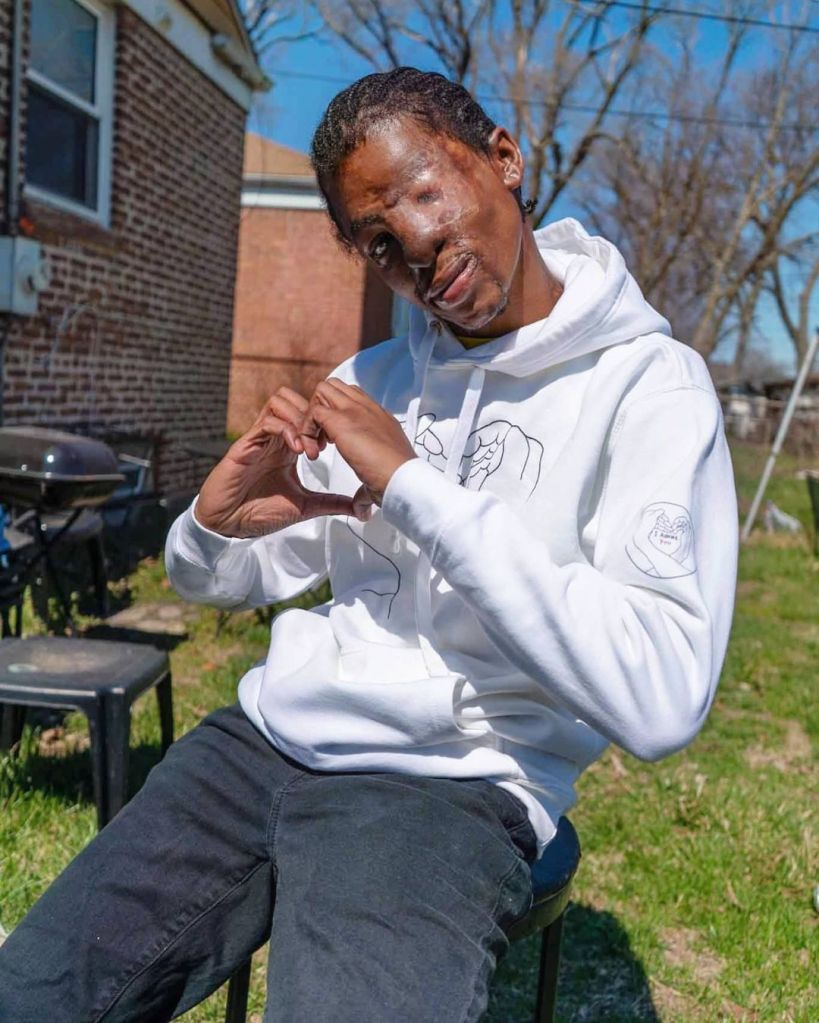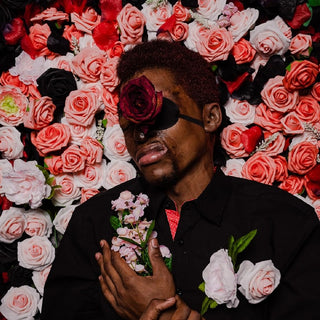WE HEART JOSHUA DIXON. YOU WILL TOO BY ALEXEY TIMBUL
Written by Alexey Timbul
I interviewed hundreds of creatives over my decade as a reporter.
This is my favorite conversation.
Meet Joshua Dixon.
Trigger warning: you will fall in love.

Every semester my fashion/media students at the Academy of Art University introduce me to a new cohort of “influencers” as we discuss social media impact on creativity and wellness (both at the individual and collective levels). Every time I “discover” someone new to be wow-ed by. Joshua Dixon was one such discovery. A multidisciplinary photographer, mental health advocate, creator of an activist fashion label Admirewear, and a conversationalist extraordinaire. He is also a survivor of a pit bull mauling that required sixty facial reconstruction surgeries. His emerging body of work is addressing trauma, defiance, joy, resiliency, grief, and other profound themes with unyielding tenderness and care. I encourage y’all to read this interview with an open heart. It just might change you, a little bit, for the better. And it will make you want a hoodie. P.S. If you or someone you know is a TED Talk producer, get Joshua on that red dot asap!
What does the term multidisciplinary mean to you as a creator?
I used to meet people and they’d say, oh I am wedding photographer, I do portraits, events, or real estate, or sports. In a business sense, being multidisciplinary means switching gears for clients. When someone hits me up for any type of shoot, instead of stepping away, I can step up and secure some memories for people. Another thing is that you can bring a certain mindset and skills from different fields into a project. For example, I learned about lighting a subject from illustration, so I use that for dramatic chiaroscuro effect. In other words, multidisciplinary means years spent working hard at becoming a photographer in my own way.
Is there a type of photography you particularly enjoy?
I found something to love about each facet of photography. In landscape photography, we witness nature grow and fight and conquer the world. It’s astounding to document that in a rose garden in someone’s backyard! [Laughs] In product photography, people often overlook how much work goes into producing any object. I spend a lot of time crafting myself as a person and an artist, so I appreciate that kind of effort.
What photographers inspire you to pursue this craft?
So many! I love Brooke Shaden’s work. It’s like she ventures into your nightmares and turns them into something beautiful. I admire Séan Alonzo Harris and the way he captures Black people, our joy, our journey. As an African American artist, I often felt left out of the “conversation”. When I saw his photos, I realized oh… He is making the conversation. He is not letting us be seen, he is makingus seen. Hearing him talk about how passionate he is about Black storytelling is amazing, because I didn’t grow up represented like that.
How would you describe your creative style?
Artistic style is a journey. If you feel like you’re all set, you stopped trying. [Laughs] Ask why, why, why. Why do it this way or that? I am a vulnerable artist, and it means the world to me to find a real connection with someone. I document my lived experiences and how I feel about them. I am showing how I am as a person. I’m bringing myself fully. Being a survivor of hate crimes, domestic violence, suicide. I get scared to put my work out there, but that’s selfcare, too. That’s what makes me me beyond having this one functioning eye and “seeing things differently”. Art is a bridge to connect people and ideas that otherwise may not find each other.
What else makes your creative journey different?
I had a lot of hate thrown at me by others and some by myself. Now I explore men’s mental health and men’s sexuality. For years I thought men literally cannot have emotions. My dad bullied me for crying or exerting any type of “feminine” emotion. He was the definition of toxic masculinity. I am learning who am I to myself as a man now, it’s important for me as a creator. What can it mean for a man to be sensual? What is it like to be a disabled black man in America? I am becoming a role model for myself growing up. It is an everyday struggle, but every day you are breathing, you get a chance to try something else, to explore the boundaries of your Self. It’s a beautiful, powerful process. I’ve been scared my whole life. I lean into my fears creatively now.
What is the biggest misconception about being an artist?
I think the biggest misconception is that we are artsy-fartsy people who don’t take life seriously. Oh, we take it most seriously. We are the critical thinkers and the problem solvers. Our emotions guide our hands. We can literally take paperand turn it into something magical! People love to bash on creatives and then consume our content. We are some of the best people, real ass people. With real ass problems, too. But we find a way to process and express that, for the sake of ourselves and others. People think making art and taking photographs is “easy.” That’s just people trying to make us feel insecure about our profession. Why view art as less valuable than other jobs?! You have your career. This is my career, my choice.
Let’s talk about Admirewear. How did this idea come about?
At the end of 2020, I was in an abusive relationship. There was violence every day. I wanted to die. I tried to die. I realized I needed help. On New Year’s Day, I checked into counseling. I would stand in front of a mirror trying to say “I love you” and I just couldn’t do it. I had to unlearn so much about myself. One day I was hurting so bad I had trouble breathing. But I made it to that mirror again and said: “You know what, I admire you.” It changed everything. I admire myself for doing what I can to stay alive, to keep going, keep creating. I pitched Admirewear for Adobe Creative Residency, but did not get the support. I thought ok, this idea is strong enough for me. During September, Suicide Prevention Month, I decided to share my own struggle openly. I didn’t know what to expect. By the end of the first month, we got over forty orders and I donated all the profits to American Foundation for Suicide Prevention (AFSP). I wanted to create a brand rooted in self-compassion so we can talk about difficult feelings. We can wear something beautiful even on days when we struggle to exist. Admirewear is saving lives. It is saving me!
What is your earliest fashion memory? A moment you realized wow clothes and accessories can be a way to express myself…
Sophomore year of high school I used to get bullied a lot in school, on the bus, at home. People would just shit on me every day. I had no escape and wrote my first suicide note. But I had this hoodie with a really large hood. It felt like being hugged. I could even cry in it, and no one cared. I wore it 24/7. It’d be hot outside and there’s little Joshua in his hoodie trying to hide from the world. With the hood up, I was able to avoid people’s stares. The less people saw me the less pain I had to endure. The safety of that hoodie let me know that I was ok. Senior year my mom got me like 20 hoodies for Christmas. It blew my mind with the pockets and zippers and T-Rexes, and galaxies, what art could do to a hoodie. When I thought about launching my own brand, a hoodie was the first item! [Laughs]
Higher ed is in flux now. What was your arts education experience like?
When I went to Maine College of Art, I’ve never been away from home before. It was a steep learning curve living on my own. C’mon, clean the room! C’mon, get organized! Can’t blame anyone! Sorting myself out prepared me to face other tough moments. There were thirteen students of color in my year. We numbered ourselves. I was Number 12. The professors did not like me. My work was not accessible to them. I heard that over and over. “Your work is not accessible!” I would ask for help and be told to google it. Once, for a final, a student submitted three stick figure drawings for a concept of a shoot when the assignment was to create a portfolio of fifteen images. I showed up with 21 photos, but they still got a higher grade than me. It made no sense to me then and it makes no sense to me still. I felt my work was sabotaged, like I was being set up for failure. I decided to challenge myself and transfer.
Number 12 with 21 photos… It was a sign to move on! How did you go about doing that?
I did google things. [Laughs] I realized that with the same instructor teaching different classes – experimental, portraiture, whatever – it was basically the exact same class, like the opposite of multidisciplinary! I bought books on photography. I started watching Skillshare videos. I started taking a ton of photos everywhere all the time. I worked really hard to become my own teacher and my own critic. I got accepted into all four schools that I applied to transfer to! I went with Art Institute of Chicago. I want to thank my Maine teachers for giving up on me, because it made me fight harder for myself.
How do you feel about failure now?
I am a big believer in failure! It’s more than ok to fail. Failure is just a challenge. Keep asking yourself why, why, why something not worked, what was about that particular obstacle that made you stop. Think about it for the next time and the next time. Everyone has their season and college just might not be yours. There are endless possibilities to thrive. Success is not defined by anyone except you. What does success mean to you? That’s what it is.
Is music a part of your creative or healing process?
Yes. I’m really into this song right now. You’re Special by NF. Cannot stop playing it. I didn’t grow up with hip-hop, but now I listen to Juice WRLD, Travis Scott, A$AP Rocky. Let me look at my playlist [Checks phone] Lil Uzi Vert, Dolly Parton, Trevor Daniel, Khalid, Ray Rockman, PnB Rock, Adele…
That’s so diverse in terms of genres, it’s almost random! [Laughs]
I love music that sounds like a part of the artist’s spirit is revealed. I’m drawn to soulful experiences that take me on a journey with the artist. Listening to music that mimics how I feel about life can help me be vulnerable. Or when the beat goes hard, it makes me switch into my next gear to match that intensity. I really enjoyed Shawn Mendes. His music felt genuine, wholesome. None of shoot this, shoot that. But then again, Chance the Rapper on PTSD talks about witnessing a murder pointblank, for example. “Certain things we ain’t talk about, mama, we just prayed off“. It raises questions about roots of mental health struggles and addiction. I value artworks that address that. I feel similarly about photography. A photograph is a song, no? It can create a space to explore how we feel about something we cannot just up and talk about.
What’s your favorite “escape” from the pressures of work, life, whatnot?
I want to say meditation, but it’s also just sitting alone in my car. [Laughs] It’s important to have a safe space, made by and for you, where you can just be, uninterrupted. I love these intimate moments with myself when it’s ok to feel the silence, to question things, to let out your emotions in a cathartic way. It allows you to go forward, to keep trying. That’s the goal: keep trying, one day at a time. I used to bully myself when I was alone. Now it allows me to connect the dots in my life. I’m thankful that what I did yesterday may help me tomorrow. I’m thankful for people who care about me. I’m learning to care for me too. That’s how I heal. But if your idea of an escape is eating pizza, I support that. Just share a slice! Let’s lay down and stare at the ceiling or the stars. That’s beautiful too.
You are based in Chicago. Would you recommend any cool places for people to explore beyond the tourist map?
Skip the tourist traps, go to North Park Village Nature Center! It is so beautiful. I’ve photographed every season there. Hyde Park is another gem of a neighborhood on the south side. You see public artworks created in the 1980’s and 90’s that speak about racism and police brutality. It makes you wonder how you can do something about things now, so they no longer feel “fresh” twenty more years later. Art always calls for change.
What advice would you give aspiring photographers and content creators?
**** the imposter syndrome. You have something. Maybe you’re a kid in the back, sitting all insecure. It’s ok to have days when you don’t got it. Let that anxious energy flow out. Let it become something else, over time. Just sketch it. Just write a few words down. It might make sense later. You’re here on a mission and your mission is to be you. Be the most beautiful flower on the f*cking planet. We too are resilient. We wilt and regrow. Our petals may fall, we turn pale, but then we bounce back looking the best we ever had. Flowers adapt to their environments to thrive. Everyday just try that, ask for help, too. Seven billion people, c’mon! There will be someone out there to support and celebrate you. Don’t let anyone stop you. There is plenty of light!
Follow and support @JoshuaDixonPhotography & @Admirewear_
If you enjoyed this interview, encourage me to write more: BuyMeACoffee!
Here is a list of mental health resources recommended by Joshua Dixon:
To Write Love on Her Arms: 20% of Admirewear proceeds benefit this non-profit dedicated to people struggling with depression, addiction, self-injury, and suicide
Here is a list of contemporary photographers recommended by Joshua Dixon:


